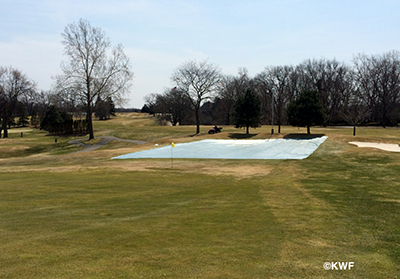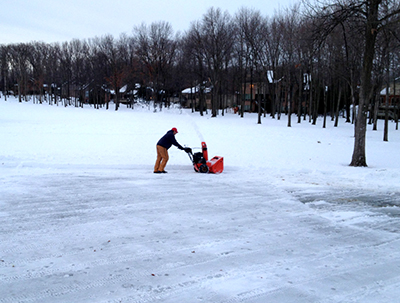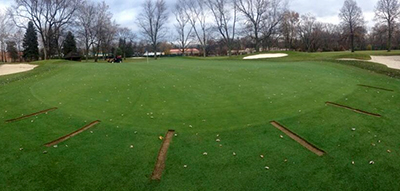Preparing golf course turf for winter
Now is the time to prepare golf course turfgrass for surviving the upcoming winter.

Every year since the record shattering winter of 2013-2014 killed turfgrass across the mid-west and northeast, somewhere in the north turfgrass has suffered winterkill. In some years it’s been ice cover that has caused death and in other years it’s been crown hydration freeze injury or even desiccation injury on exposed sites causing damage. With winter on the horizon, there is plenty of discussion on what to do now and what to do during winter to minimize the risk of winterkill.
Shade
Winterkill preys on weak turf. In many instances, winterkill patterns mirror shade patterns on greens. Turfgrass growing in the shade is simply not as healthy as turfgrass growing in full sunlight. To compound the problem, trying to reestablish damaged greens in the shade results in longer recovery time than greens recovering in full sunlight. Improving sunlight penetration to greens by removing or thinning tree canopies will improve turfgrass health and ultimately may improve the odds of turfgrass surviving winterkill events.
Covers

Covers are not widely used throughout Michigan. There are probably several reasons including cost, storage, lifespan and unpredictable winter weather. Some winters are extreme with long periods of ice, snow and cold temperatures while others are mild. Keep in mind that all covers are not the same. The permeable covers that some golf courses have provide a tremendous advantage in reestablishment, but will not provide absolute protection in the winter from thick ice cover. Permeable covers will certainly provide some buffer or protection from low temperatures and desiccation and should be used if available, but if winter delivers a dose of lengthy ice cover, permeable covers can’t be counted on to prevent damage.
Impermeable covers will protect the turf from ice cover damage, but are not necessarily a panacea for all your winter worries. Impermeable covers need to be “tucked down” tightly to the surface to prevent any water from getting under the cover. Impermeable covers will prevent gas exchange with the atmosphere, so in that respect they actually mirror thick ice sheets. Venting (exchanging air under the cover) impermeable covers has been used successfully throughout winter to reduce the risk of anoxia developing under the cover.
To use or not use covers, especially impermeable covers, can be a hotly debated topic. Ultimately, the golf course superintendent is the person that should make the decision. After all, no person knows the golf course, the environment and the turf better.
Snow mold and covers
It is important to remember that greens covers act similar to snow cover when it comes to snow mold activity. The covers provide the same environmental conditions for the development of snow mold as the snow does. So if greens covers are placed on the greens in November and not removed until March, they will create the same environmental conditions for the development snow mold as golf courses in northern Michigan experience where snow covers the turf for three or more months.
It is important that adequate levels of snow mold fungicides be applied to protect the turf for three or more months if covers will be used for this length of time. This usually means applying three-way fungicide combinations at full label rates.
Microdochium patch will occur throughout the fall. It is most active when the temperatures are in the 60s and combined with wet weather. Therefore, it is important to make fungicide applications throughout the fall to prevent Microdochium patch from developing. If Microdochium patch is active at the time the covers are placed on the greens, it will continue to develop under the covers in spite of any fungicide applications.
Winter snow and ice removal: To remove or not to remove?

This question might make the cover debate seem tame. Should you remove snow and ice and if so, when should you start? Although some courses have been successful with removing snow throughout the winter, this is not feasible for many courses due to either lack of personnel or snow moving equipment.
Instead of being concerned with removing snow from the first event to the last, consider developing a removal strategy that targets ice duration and snowmelt that could lead to crown hydration freeze injury. For example, if ice forms and is in place for greater than 30 days on annual bluegrass greens, I would definitely make attempts to remove. For crown hydration freeze injury, Michigan State University Extension recommends to consider removing snow in late winter/early spring prior to anticipated snowmelt.
Surface drainage

The key to preventing or reducing the incidence of crown hydration freeze injury is good drainage. For putting greens that lack adequate surface drainage, consideration may even be given to recontouring greens that are annual victims of crown hydration injury. Less dramatic measures include cutting cup cutter-sized holes in poorly draining areas and filling the cores with gravel or sand to try and move the water away from the surface. Another more common tactic is to cut sod strips from greens to facilitate water movement off the greens once snowmelt begins.
Cultural practices – let it grow!
Fall is prime time for cultural practices to improve turfgrass health. In addition to core aeration and fall fertilization, consideration should be given to raise mowing heights as fall progresses. Higher mowing heights won’t save the turf alone if winterkill is again an issue, but it could certainly be a factor in producing a healthier plant and if you think back, how many putting greens had winterkill, but the collar had no damage? Granted, the greens aren’t going to look like collars going into winter, but maybe even a slight increase in height might help.
Dr. Frank’s work is funded in part by MSU’s AgBioResearch.



 Print
Print Email
Email


